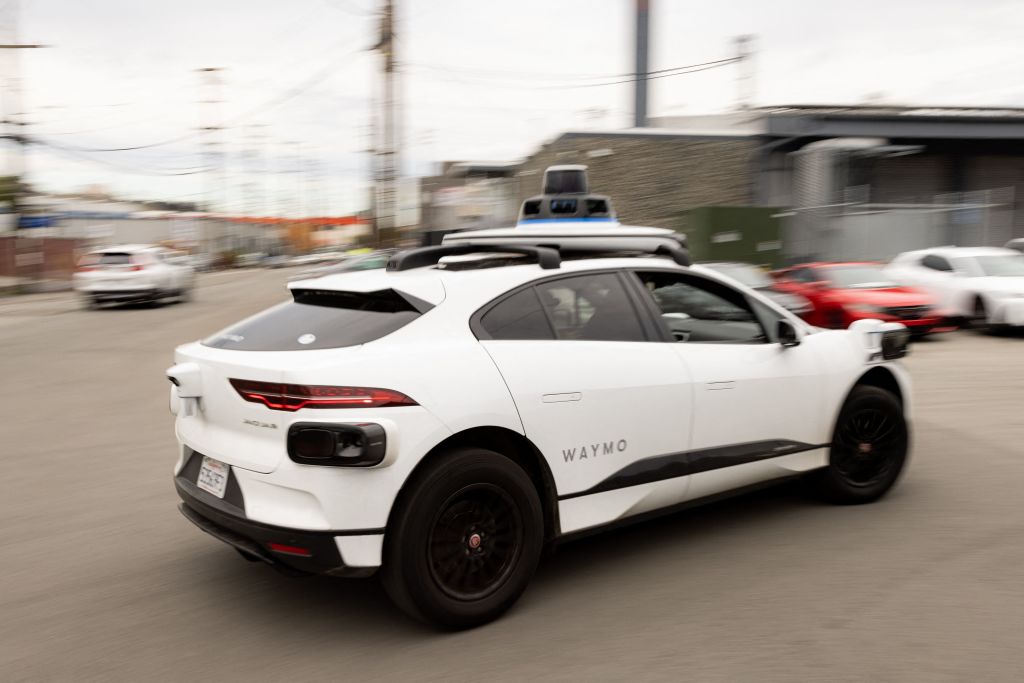By Hannah Elliott, Bloomberg
There’s something fundamentally American about the freedom to get in your car and drive.
Driving is self-determination. The liberty to set your own course. The power to move under your own willpower, whether for duty or sheer pleasure. Despite some decline among Gen Zers, plenty of teens still eagerly anticipate getting their driver’s license. In many American towns, where public transportation and walkability are scarce, driving is what empowers you to explore.
RELATED: A Waymo car pulled over for an illegal U-turn has no driver. What happens next?
Some motoring enthusiasts worry self-driving vehicles threaten that ideal. These robot autos, run by Google and China and Elon Musk, use AI and radars to navigate without human input; they could replace our car-centric culture with faceless communal bots controlled by opaque entities. Even worse, self-driving vehicles present safety concerns and other vulnerabilities, such as being hacked or spoofed by malicious agents at home or abroad.
Related Articles
Lyft plans fleet of hundreds of Tensor Robocars from 2027
Tesla’s ‘full self-driving’ faces another federal safety probe
Family of East Bay Cybertruck crash victim sues Tesla over alleged design flaws
Who is accountable when a driverless car breaks the law?
Tesla settles another fatal crash suit ahead of East Bay jury trial
I’ve covered the car industry for 20 years, and I would hate to see our sports coupes and road trips disappear. The risks associated with relinquishing control over my mobility also give me pause. Or they did. I took a Waymo for the first time recently in Los Angeles and … I haven’t stopped using it since. Rather than replace our cool cars, self-driving vehicles will, I predict, become a welcome compliment to modern life, first as part of ride-sharing platforms and then as privately owned transport. Why? Because they offer an excellent solution for something nobody likes: commuting.
If driving is heaven, commuting is hell. Not even the hardest-core drivers like it. So the question isn’t whether self-driving will replace our favorite cars (I think not), but rather, will it remove the burden of our most mundane trips? And could it replace other ride-sharing platforms like Uber? I certainly hope so.
***
Waymo LLC, the self-driving car service subsidiary of Alphabet Inc., Google’s parent company, was founded in 2009 with a mission to explore what self-driving technology could offer. It now has more than 2,000 electric vehicles operating across its markets, which include LA, Phoenix and San Francisco, plus Austin and Atlanta, where Waymo rides are hailed via Uber. In 2026, Dallas, Denver, Miami, Nashville and Washington, DC, will join the ranks with Waymos on their streets. New York City just granted the company permission to continue testing there until the end of the year, and Seattle is in the works too. Waymo provides more than 250,000 trips each week, and regulators are already adapting. A new California law will soon authorize police to issue “notices of autonomous vehicle noncompliance” when they see driverless cars breaking traffic rules.
Beyond Waymo, robo-taxis and -shuttles are also running in China, Singapore and the Middle East, and they’re being tested across Europe. The vehicles are expected to become commercially available in the US at a large scale by 2030, according to the research firm McKinsey.
But they’re a long way from being ubiquitous. A world of self-driving cars will require billions of dollars of development, improved navigation systems, increased charging infrastructures and new regulations to amend traffic laws. Ford, General Motors and Volkswagen have all canceled autonomous taxi programs they once funded by the billions. (GM is planning to renew exploring autonomous cars for personal use, rather than as a robotaxi service.) Tesla’s Robotaxis aren’t open to the public. Given the company’s proclivity for extensive delays, it’s unclear when they will be.
As self-driving options develop, consumer demand shouldn’t be a problem, according to experts; most people who try it like it. Waymo reports a 98% satisfaction rating among users in LA. Proponents note that more than 1.3 million deaths occur around the world annually in traffic accidents, whereas self-driving vehicles eliminate the human errors that cause more than 90% of those deaths, according to research by Global Market Insights.
Waymo uses a proprietary AI system for autonomous driving that has been installed on a fleet of Jaguar I-PACEs equipped with dozens of cameras and sensors. The technology is more robust than the hands-free driving systems we have in our own cars, combining AI learning with LiDAR, radar, cameras and high-definition maps to read and anticipate the environment.
There are still significant limitations to Waymo vehicles’ range and their ability to adapt to real-life scenarios. But after a week of Waymo rides, which I ordered easily via an app, other ride-sharing platforms seemed woefully outdated.
***
My first trip was not perfect. Our house in Hollywood sits outside Waymo’s range, so my gallant husband had to drive me about a mile down the hill to a cafe on Hollywood Boulevard, where I ordered the car. It took 26 (!) minutes to arrive—precious time lost because of high rider volume on a Monday morning. An Uber would have been there within a few minutes. But the vehicle showed up at exactly the time it had promised, unlike Uber, which tends to miss arrival estimates. A spokesperson from Uber declined to comment.
Synched with my iPhone, the car unlocked automatically when it pulled up, waiting until I clicked my seat belt and pushed a green button on a screen in the rear to commence the journey. Icons in the app would have let me open the trunk, had I wanted, and allowed me to adjust the sound and temperature in the car.
Any drama I expected to feel from being alone in a moving vehicle just didn’t exist. No driver? No problem. I forgot about it before I even hit Santa Monica Boulevard, and my 44-minute ride to the office proved delightfully uneventful while my productivity soared: I stretched my legs; checked email; made phone calls and wrote to-do lists—all things I cannot do when driving myself to the newsroom each morning. The trip cost $23.28, almost half the price of an Uber Black ($41.25) or UberX ($42.95) at the same hour.
There were a few hiccups. The car froze momentarily behind a truck parked illegally, causing other drivers to honk erratically. More annoyingly, it didn’t drop me at the address I requested but in a hotel valet line across an intersection and down the next block. I’ve learned that Waymos often leave passengers on side streets or one block past a chosen destination, depending on how busy the drop-off point seems. (This is because the cars are programmed to prioritize safety and efficiency rather than moving swiftly in hectic traffic.) That would have been frustrating had it been raining, or an unfamiliar neighborhood, or had I been wearing heels.
There’s room for improvement in the car’s ability to take a direct route to a destination rather than zig-zagging or circling the arrival spot before stopping, as it did one evening when trying to avoid busy corners to drop me off in Hollywood. It made for a slightly longer drive than if I had done it myself. Indeed, the logistical challenges of using Waymo are its biggest problem. One night it wouldn’t let me change my destination just 15 minutes into a 55-minute journey, even though the new destination was far closer. (It would have allowed me to cancel the ride, leaving me on the street corner.)
I’m hoping all this will improve as Waymo expands its range—and incorporates highways and Interstates, which it currently does not—because the privacy, punctuality and peace inside the cabin are delightful. I found myself scheduling Waymos to take me to dinner in West Hollywood or to try on shoes at Reformation on Melrose Avenue. It was freeing not to stress about parking or bad drivers.
If more folks used self-driving cars, it would lead to more parking; reduce road rage, drunk driving and traffic accidents; and alleviate noise pollution and congestion. Waymo is a far better driver than most of the ride-sharing and taxi drivers I’ve had. It’s certainly more courteous, gliding elegantly through yellow lights, and moving up in line at stoplights if the vehicle behind it wants to turn right. The car remained smooth and predictable even in tight traffic, navigating tiny neighborhood streets with ease. I was so relaxed I started dozing.
One morning I even walked myself 20 minutes down to the Hollywood coffee shop so I could take a Waymo again to work. I didn’t love the hike, but I wanted that solitary ride. (Mornings when I needed to be in the office at a specific time, I drove myself.)
The solitude is the top benefit I hear from everyone I speak with about the service—especially women and gay and trans friends who worry about being accosted, harassed or ogled by drivers. Self-driving cars offer a way to ride alone in safety. We just need the services to be bigger and better and more flexible.
It’s encouraging to see the industry growing, with companies like Zoox, Pony Ai and WeRide working to expand the technology. In 2024 the global market for self-driving cars was valued at $1.7 trillion, according to Global Market Insights. It’s expected to hit $3.9 trillion by 2034.
As for me, I’ll plan to hold on to my cars and use Waymo for my daily commute and mundane chores. If I’m lucky, I’ll never have to take an Uber again.
More stories like this are available on bloomberg.com
©2025 Bloomberg L.P.





